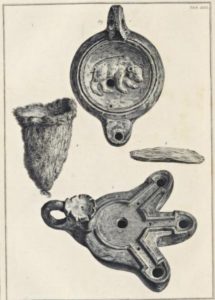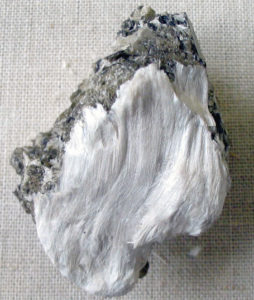by Lisa Smith (Regular Contributor)
John and Andrew van Rymsdyk’s guide to the British Museum, Museum Britannicum (1778), is an intriguing and fun little book. It introduces the reader to a small group of objects on display in the late eighteenth century at the British Museum, which ranged from gems and amulets to kidney stones and sepulchral lamps. The book contained drawings of and historical reflections on each chosen object, with the authors making reference to books in the Museum’s library, as well as their own experience. I could linger happily on many aspects of the book, but allow me to introduce the ugliest (I think) item in the collection: an asbestos purse.
The engraving in the book (pictured here) does it few favours, but the modern photo at the Natural History Museum shows that it hasn’t aged well. Why would anyone want such a purse?
The book is provides a short history of asbestos (pp. 55-56), suggesting that asbestos properly belonged in the British Museum, being a native stone found throughout the British Isles (as well as many other parts of the world). Its appearance is unusual, even pretty: ‘whitish silver colour, consisting of small threads or longitudinal fibres’. It wouldn’t dissolve in water… and it would resist fire, only becoming whiter when it burned!
The van Rymsdyks were particularly interested in the potential applications of the stone. While short fibres were only good for making paper or torches, but longer fibres—which could be found in Aberdeenshire, no less—could be used to make cloth. This had two benefits. As van Rymsdyk reported, cleanliness was one use:
I have seen a Gentleman, a kind of Philosopher, at Amsterdam, who had a tasty Night-cap of it, which when foul he would throw into the fire, and became better clean than if it had been washed with soap and water, as we do linen.
The Ancients, according to the author, prized the cloth even more than pearls. It was used as shrouds for royalty, wicks in perpetual lamps, treating skin problems (!), and more. But the second greatest use might be to save lives—and could even be manufactured in Britain, using British stones. Van Rymsdyk implored: ‘For how many Ladies, Valetudinarians and Children have been burnt by their Cloaths catching Fire, for want of them being made from the Asbestos?’
The feasibility of asbestos cloth-making had been called into question earlier in the century. In his Cyclopædia, or, An universal dictionary of arts and sciences (1728), Ephraim Chambers commented that although many
have pretended to the Secret of spinning the Asbestos… this should seem hardly practicable, without the Mixture of some other very pliant Matter, as Wool, Line, or Hemp along with it; the Filaments of the Amianthus it self being too brittle to make any tolerably fine Works (147).
Indeed. The purse is not ‘tolerably fine’, although it was more clothing-like than the other examples of asbestos cloth in the British Museum, which included ropes, nets and paper. That, presumably, was the reason for the van Rymsdyks including it in their guide to the Museum: a chance to highlight the possibilities for British industry and health.
As to who would want the purse in the first place: Benjamin Franklin (1706-1790) and Sir Hans Sloane (1660-1753). The purse came from Sloane, whose collection was the founding core of the British Museum. Sloane had purchased it from Franklin in 1725, no doubt fascinated by the human industry in creating a fire-proof purse out of a natural curiosity–a stone with fibres.
I had brought over [to London] a few Curiosities among which the principal was a Purse made of the Asbestos, which purifies by Fire. Sir Hans Sloane heard of it, came to see me, and invited me to his House in Bloomsbury Square, where he show’d me all his Curiosities, and persuaded me to let him add that to the Number, for which he paid me handsomely.
Although Franklin did not elaborate on how the fibres were made tough enough to weave, Pehr Kalm (Swedish-Finnish naturalist, 1716-1779) later noted that Franklin had told him the method; when the fibres were left outside in the cold, wet air of winter, they would ‘grow together and become tougher and more suitable for spinning’.
But just because you can do something, doesn’t mean you should. Given that asbestos can cause itchy skin, it would have made for some terribly uncomfortable clothes—for children and ill people, no less! Knowing what we do about asbestos now, it’s just as well it wasn’t used even more widely than it already was.
Plus: the cloth is ugly.


